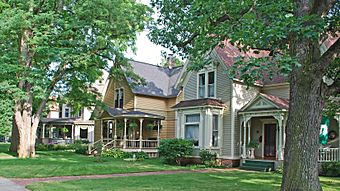Central Neighborhood Historic District facts for kids
Quick facts for kids |
|
|
Central Neighborhood Historic District
|
|
 |
|
| Location | Roughly bounded by 5th, Locust, Union, 9th, and Division Sts., Traverse City, Michigan |
|---|---|
| Area | 121 acres (49 ha) |
| Architectural style | Italianate, Neo-Georgian |
| NRHP reference No. | 79001154 |
| Added to NRHP | December 11, 1979 |
The Central Neighborhood Historic District is a special area in Traverse City, Michigan. It's a neighborhood filled with old homes and buildings that are important to history. This district is roughly located between 5th, Union, 9th, and Division Streets.
In 1979, this neighborhood was added to the National Register of Historic Places. This is a list of places in the United States that are worth protecting because of their history. The district includes 459 structures, which means many buildings. One famous building here is the Perry Hannah House, which is also listed on its own.
A Look Back: History of the Central Neighborhood
The Central Neighborhood started to grow a long time ago. Most of the houses were built between 1890 and 1914. This was around the start of the 20th century.
Many interesting people lived here when the neighborhood was new. For example, Perry Hannah, who was a very successful lumber businessman, lived here. His son, Julius, and daughter-in-law, Elsie Raff, also lived in the neighborhood. John Morgan, who owned a fruit canning company, was another resident. His son, "Wild Bill" Morgan, later became the mayor of Traverse City. Cuyler Germaine, a business executive, and Dr. James Munson, who was in charge of the Northern Michigan Asylum (a hospital), also called this place home.
What makes this neighborhood special is that people from many different jobs and backgrounds lived side-by-side. This mix of residents made the community very unique.
Exploring the Neighborhood: What You'll See
The Central Neighborhood Historic District covers about 121 acres. That's a lot of space! It's mostly a place where people live. You'll find 407 single-family homes here. There are also 44 smaller buildings, like garages or sheds. Plus, there are eight churches and schools within the district.
When you walk through the neighborhood, you'll see many different styles of houses. Some common styles include Queen Anne, Italianate, and Neo-Georgian. These are all types of architecture that were popular when the houses were built. They give the neighborhood a charming, historic look.





